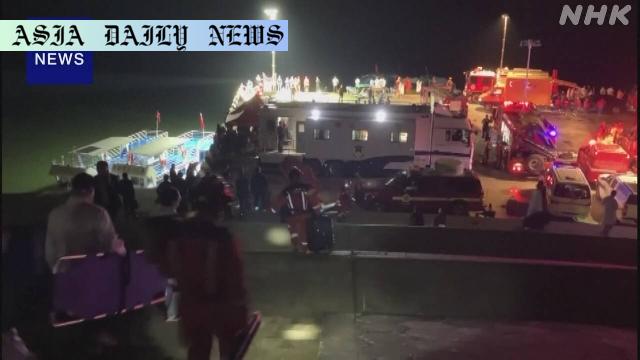Capsize: Four tourist boats capsized in Guizhou, China, leaving ten dead as sudden downpours and strong winds caused chaos.
Four tourist boats capsized in Guizhou amid bad weather conditions.
The accident claimed 10 lives, with 70 rescued and treated.
President Xi Jinping instructed to enhance safety measures at tourist attractions.

Tragedy Amidst May Day Celebrations
A tragic incident struck the Guizhou province in China during the country’s much-celebrated May Day holiday. Four tourist boats, navigating a river popular with visitors, capsized in adverse weather conditions, leaving ten people dead and scores injured. State-run Xinhua News reported that a total of 84 passengers and crew members were thrown into the river in the horrific incident, leaving local communities and holiday-goers reeling with shock.
The accident unfolded on Sunday, amidst a spike in tourist activity during the five-day May Day break. Heavy downpours and fierce winds significantly reduced visibility, creating challenging conditions for boat operators. It is believed these sudden weather changes led to the fateful capsizing of the vessels. Officials launched an extensive rescue operation, ultimately saving 70 individuals who received hospitalization. Thankfully, their conditions were reported as non-life-threatening, but many were left shaken from the ordeal.
Responses from Leaders and Authorities
Following the tragic event, President Xi Jinping took swift action, urging authorities to bolster safety standards across tourist attractions and transportation systems. His instructions were clear—such incidents must be avoided, especially during times when large numbers of people travel across the nation for holiday festivities. This event serves as a stark reminder of the importance of preemptive measures when it comes to public safety at popular attractions with high traffic during holidays.
Tourism plays a significant role in Guizhou’s economy, and such incidents could adversely affect the region’s reputation. The rapid responses from authorities, however, showcased a commitment to mitigating further damage and ensuring the well-being of both locals and visitors. Emergency protocols were immediately enacted, and safety audits of similar tourist destinations may soon follow to prevent such tragedies in the future.
A Closer Look at Weather’s Role in Tourist Safety
Weather has proven to be an unpredictable force, often taking unassuming travelers by surprise. In this incident, the combination of sudden downpours and strong winds played a central role in causing chaos and confusion. Such events underline the need for rigorous monitoring of weather conditions and enhanced communication systems to alert those managing transportation at tourist destinations. Tour boat operators, especially, must be prepared with comprehensive contingency plans to adapt to changing weather patterns rapidly.
China’s tourism sector, which had begun to recover significantly following the easing of COVID-related restrictions, must now confront these added challenges. Strengthening the safety infrastructure and building trust among tourists remain imperative in ensuring long-term sustainability in such travel hotspots.
Conclusion: Lessons to Be Learned
The tourist boat capsizing incident in Guizhou opens up a critical dialogue about the convergence of human caution and natural unpredictability. The loss of ten lives is a somber reminder that while we cannot always control the elements, proactive safety measures can significantly reduce risks. Government officials, tour operators, and local authorities must collaborate to create a resilient safety network that protects the lives of both citizens and visitors during high-demand times.
Public safety campaigns, combined with enhanced technological systems for monitoring and responding to emergencies, must become a priority. Only through such a holistic approach can we honor the lives lost and endeavor to ensure safer travel environments for all in the future.



Commentary
The Global Impact of Local Tragedies
This tragic incident in Guizhou, China, reverberates well beyond the borders of the province or the nation itself. It captures the inherent risks associated with tourism at nature-centric locations. As people flock in large numbers during holidays, especially after prolonged restrictions due to pandemics or other crises, the potential for chaos and tragedy cannot be overlooked. Planning and preparation must grow in equal measure to the increasing crowds.
Weather remains a critical wild card in the tourism industry. Even in cases where forecasts predict adverse conditions, the sudden onset of storms or winds can often catch individuals off guard. The Guizhou incident is a case in point, underscoring the importance of immediate updates and communication systems. Advanced meteorological tools and dissemination methods for warning should become essential at popular tourist hubs worldwide, not just in China.
Reflections on Leadership and Responsibility
President Xi Jinping’s prompt call for enhanced safety measures highlights the importance of leadership in navigating post-tragedy circumstances. Leaders have a dual responsibility—first, to address the immediate aftermath effectively with rescues and aid, and second, to ensure systemic changes take place to prevent repeated incidents. Xi’s move to refocus efforts around safety serves as a commendable example, but such leadership must cascade down to local levels for tangible improvements to materialize.
The tourism industry, globally and locally, must recognize tragedies like this as opportunities to learn. By examining the causes—whether weather, inadequate infrastructure, or negligence—stakeholders can pivot toward crafting solutions that safeguard individuals without hindering the experiences that make such destinations attractive in the first place.
The Human Element in Natural Incidents
Beyond statistics and headline numbers, the ten lives lost represent human stories, families left behind, and dreams unfulfilled. Each individual involved, from the deceased to the rescue personnel, highlights the fragility yet resilience of our shared humanity. Events like these serve as stark reminders of life’s uncertainties and the importance of cherishing safety above all.
It is crucial to ensure that not only are safety systems in place but also that people understand and respect them. Awareness campaigns focusing on the potential risks of natural tourist attractions can empower tourists to make informed choices. Ultimately, collective responsibility—on the part of governments, businesses, and tourists—must drive us toward ensuring safe and memorable travel experiences for all.